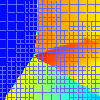Movie Theater
Recent movies
For recent movies, please visit my youtube channel.
Gas accretion onto binary stars
This simulation reproduces the circumbinary disk with two spiral arms. Such features coincide with ALMA observation toward L1551NE binary stars. The calculation was performed by SFUMATO AMR code. The movie with the English sub is here. See the press release for details. You can download movies without subtitles in the rest frame and the rotating frame.
Multiple-star formation in a turbulent cloud core.
This simulation reproduces multiple star formation in the turbulent cloud core. This model mimics the dense core, MC27/L1521F, which was observed by ALMA telescope. The calculation was performed by SFUMATO AMR code. The movie with the English sub is here. See the press release for details. You can download a movie without subtitles and with sink particles (recommended).
Wind tunnel with a step with AMR
Density distribution with blocks, Density distribution without blocks, Node distribution.
Calculation of the wind tunnel with a step. Wind of Mach 3 flows from left to right direction. Each AMR block consists of 8×8 cubic cells. The scheme is RoeM2, which is stable for the carbuncle phenomenon, with the third-order accuracy in space and the second-order accuracy in time.
Double Mach reflection problem calculated by parallel adaptive mesh refinement
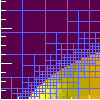 Density distribution (453KB) , Node distribution (423KB)
Density distribution (453KB) , Node distribution (423KB)
Test calculations reproducing the Mach stem. The calculation is performed by a three-dimensional, block-structured, parallel adaptive mesh refinement (AMR) code. Each block consists of 4x4x2 cubic cells. Peano-Hilbert space-filling curve is adopted in order to partition data into the nodes for each grid level separately (see the movie of node distribution).
Outflow formation in a collapsing cloud core
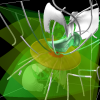 3D view (1.8MB)
3D view (1.8MB)
Collapse of a magnetized molecular cloud core and formation of a first core, a circumstellar disk and an outflow. The calculation is performed by a three-dimensional MHD nested grid code. The color iso-surfaces denote the iso-density surfaces. The tubes denote the magnetic field lines. The white iso-surfaces denote the iso-velocity surfaces, which represent an outflow. See this paper for detail.
Several types of Binary formation
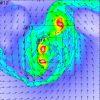 Ring-bar type(19MB), Satellite type(28MB), and more.
Ring-bar type(19MB), Satellite type(28MB), and more.
Binary formation calculated by a three-dimensional nested grid code. The movies show the cross-sections in the mid-plane (upper panel) and meridian-plane (lower panel). The color and arrows denote the density and velocity. Note that the frame is magnified according to the collapse of the cloud. See this paper for detail.
4D2U project of NAOJ created a more impressible movie by using this simulation data. Download a zip file at this page.
Sequential formation and merger of dense clumps in the first core
 3D view (2.6MB) The color isosurfaces denote the density in the logarithmic scale. Dense regions, clumps, are seen in red. The clumps are formed in a rotating disk and fall into the central object, young protostar. The green region corresponds to the first core. In this simulation, the first core is disk shape.
3D view (2.6MB) The color isosurfaces denote the density in the logarithmic scale. Dense regions, clumps, are seen in red. The clumps are formed in a rotating disk and fall into the central object, young protostar. The green region corresponds to the first core. In this simulation, the first core is disk shape.  2D view (11MB)
2D view (11MB)
Same as the above movie but presented in cross-section. The color also denotes the density in the logarithmic scale. The clumps are seen in yellow-white color.
Fragmentation of the elongated first core calculated by nested gird
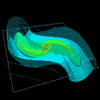 In grid level 11 (1.1MB)
In grid level 11 (1.1MB)
Fragmentation in the center of the cloud. Red isosurfaces denote fragments. This movie shows an only small region of the whole computation domain. The calculation is done width the nested grid having grids of levels 1-12. This movie shows the area of level 11. 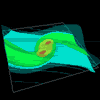 In grid level 12 (1.1MB)
In grid level 12 (1.1MB)
Same as the above movies but shows the area of level 12, the finest grid. This movie shows the twice smaller region than the above movie.
Test runs for nested grid codes
 HD code (7.1MB)
HD code (7.1MB)
This movie shows test runs for our hydrodynamical nested gird code. A recipe of the test has shock tube problems, propagation of shock waves in several directions, propagation of small perturbation, and etc.  MHD shock tube problem in view of 1D (0.4MB)
MHD shock tube problem in view of 1D (0.4MB)
The upper and lower dots denote the density and velocity distributions, respectively. Note that the computation is fully three dimensional. This movie shows the values in a line which is parallel to the propagation direction of the shock wave. The dots in red, green, blue dots denote the values in the grid level one, two, and three, respectively.  MHD shock tube problem in view of 2D (1.4MB)
MHD shock tube problem in view of 2D (1.4MB)
The same as the above movie but shown in cross-section. The grayscale, arrows, red curves denote the density distribution, velocity, and magnetic field lines.
Bar and disk formation in collapsing isotheraml clouds
 bar formation through a rotating disk (1.6MB)
bar formation through a rotating disk (1.6MB)
See this paper.  non-rotating disk formation (1.5MB)
non-rotating disk formation (1.5MB)  vertical bar formation (1.3MB)
vertical bar formation (1.3MB)


